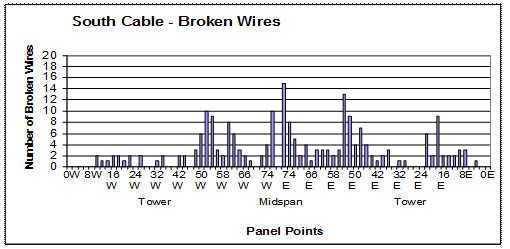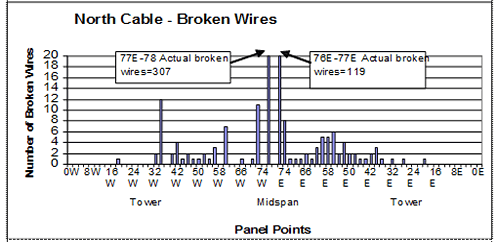U.S. Department of Transportation
Federal Highway Administration
1200 New Jersey Avenue, SE
Washington, DC 20590
202-366-4000
Federal Highway Administration Research and Technology
Coordinating, Developing, and Delivering Highway Transportation Innovations
| REPORT |
| This report is an archived publication and may contain dated technical, contact, and link information |
|
| Publication Number: FHWA-HRT-14-023 Date: May 2014 |
Publication Number: FHWA-HRT-14-023 Date: May 2014 |
Currently, all State and local agencies responsible for the maintenance of suspension bridge cables base their maintenance plans primarily on previous experiences and on information from limited inspections. Usually, the exterior covering of a cable is visually inspected biannually. If such inspections reveal deterioration problems, the cable undergoes an indepth inspection if the maintenance budget allows for such undertaking. The cable is then unwrapped at a few locations along the cable length and is wedged into its center. Next, a visual inspection of the wires' conditions is performed, and in some cases, a few wires are cut and removed for laboratory testing. As a result of NCHRP Project 10-57, guidelines for inspections have been developed so as to standardize such cable inspections.(1)
In depth inspections of cable systems in aging suspension bridges in the City of New York area and the broader Midatlantic region have often shown that there are many broken wires inside the cables and at the anchorages, indicating brittle fractures and extensive corrosion. These alarming findings are inexplicable, and the reason for the presence of such broken wires must be found in the complex deterioration process with a main cable. While the effects of corrosion on ordinary structural steel are mainly due to a loss of material and the ensuing reduction of the cross sectional areas of members, the failure of high-strength bridge wires manifests itself, in addition to the loss of material, in a number of related phenomena referred to as stress corrosion, corrosion cracking, corrosion fatigue, and hydrogen embrittlement. These phenomena appear to have a much more detrimental effect on the strength of wires than just the reduction of the wires' cross section area.
All these interacting and complex deterioration mechanisms play a fundamental role in determining the actual strength of bridge cables. The current methodologies do not account for the actual deteriorated conditions of the wires; the use of a ductile model for the estimation of the residual cable strength has been proven to be valid only for new bridges and overestimates the actual cable strength in existing bridges. In addition, there are overwhelming problems related to the uncertainties in the current inspections' data since these indepth inspections are conducted only at a few selected locations along the bridge length, usually at locations that appear to be in the worst conditions from a visual point of view.
The effectiveness of all these methodologies for estimating the remaining cable strength, however, depends on the reliability and completeness of the information that is extracted during inspections. Unfortunately, current visual inspections do not provide an adequate amount or sufficiently reliable data, highlighting the need for innovative non-destructive testing (NDT) and sensing technologies that can provide an immediate, comprehensive, and reliable assessment of cable conditions and their evolution with time either directly or through measuring related variables (i.e., temperature, acidity, humidity, etc.).
The goal of this research project was to develop an integrated system that uses state-of-the-art sensing capabilities and non-destructive evaluation (NDE) technologies to assess cable conditions. Based on this study, it is reasonable to say that a smart sensor system integrated with global NDE technologies and that would map the entire length of the cable is an accurate tool for reliably assessing the condition of suspension bridge cables.
Current inspection procedures of suspension bridge main cables mainly consist of visually inspecting the exterior covering of the cable every 2 years. A team of inspectors observe the surface of the cable protection materials and report the findings regarding cracks and chipping of materials (neoprene wrapping or paint), signs of water and residue leaking from the cable (mainly at cable band locations), and other indications and levels of deterioration of the wrapping/painting materials. An indepth inspection is usually scheduled as necessary to assess the condition of the interior wires by wedging the cable at radial groove positions at selected locations along the cable. These locations are usually limited to about eight or less, and the evaluation is based on a combination of heuristics and statistical considerations. However, such approaches were discovered to be deficient in uncovering the most deteriorated and weakest regions in the cables of several bridges during their full cable rehabilitation projects.
In figure 1 and figure 2, the number of broken wires along the south and north cables of an 80-year-old bridge is plotted as a function of the location along the cable length. For each panel, the length of the cable between two consecutive cable bands was defined. Each cable was divided into two segments indicated by "W" or "E," where "W" indicates the part of the cable west of the central point, and "E" indicates the east part of the cable. Two panels (77E-78E and 76E-77E) on the north cable have a number of broken wires (307 and 119 out of 18,666 wires, respectively) that are off the charts. It is clear that locations of breaks within the main cable and the number of broken wires cannot be characterized with any specific pattern, and such data cannot be accurately predicted by inspecting some selected locations along the cable. Even when the cable is wedged open, the total number of visible wires that are exposed is limited to about 2 percent of the total number of wires in a cable cross section.
Traditionally, during the indepth inspection procedure, the wires are classified in four stages of wire deterioration, which are characterized by the presence of the following (NCHRP Report 534):(1)
The following conclusions were made based on a 1998 comprehensive analysis of the suspension bridge inspections in the City of New York metropolitan area:(3)

Figure 1. Graph. Number of broken wires along the south cable of an 80-year-old bridge
during rehabilitation

Figure 2. Graph. Number of broken wires along the north cable of an 80-year-old bridge
during rehabilitation
A listing of the bridges, from which the previous conclusions were drawn, and the status of their inspection and/or rehabilitation are provided in table 1.(3) In this study, more than 100 inspection reports for the main cables of the 10 suspension bridges in the New York metropolitan area were reviewed and analyzed. Most of these bridges underwent various cable inspections over their life time, with unwrapping, wedging and, in some cases, oiling of the cables.
Table 1 . List of City of New York cable suspension bridges with corresponding indepth inspection and cable rehabilitation.
Bridge Name |
Year Built |
Number of Cables |
Cable Diameter (inch) |
Indepth Inspection (Y/N) |
Cable Rehabilitation (Y/N) |
|---|---|---|---|---|---|
Brooklyn |
1883 |
4 |
15.75 |
Y |
Y |
Williamsburg |
1903 |
4 |
18.75 |
Y |
Y |
Manhattan |
1909 |
4 |
20.5 |
Y |
Y |
Triboro |
1936 |
2 |
21 |
Y |
Y |
George Washington |
1931 |
4 |
36 |
Y |
N |
Throgs Neck |
1961 |
2 |
21 |
N |
N |
Whitestone |
1939 |
2 |
21 |
Y |
Y |
Bear Mountain |
1924 |
2 |
22 |
Y |
Y |
Mid Hudson |
1930 |
2 |
16.75 |
Y |
Y |
Verrazano |
1964 |
4 |
36 |
Y |
N |
1 inch = 25.4 mm
The pattern of cable deterioration at various locations depends on many factors such as stresses, geometry, exposure to acid rain, sun and wind, construction details, etc. Usually, the outer wire layers show a higher degree of degradation and a larger number of broken wires, especially in the lower portion of the cable's cross section, while wire conditions improve toward the inner layers. However, depending on the procedures used at the time of the bridge's construction, the deterioration pattern may be reversed, and the inner wires may be in much worse conditions than those in the outer layers.
The environmental deterioration of bridge wires is a result of electrochemical processes and their interaction with mechanical stresses. Although atmospheric air is the most common in the environment, aqueous solutions, including natural water, atmospheric moisture, and rain as well as man-made adverse chemical solutions are the conditions most frequently associated with degradation problems. In bridge wires, various forms of material deterioration have been associated with the word "corrosion," including surface corrosion, corrosion pitting, inter-granular and crevice corrosion, stress corrosion, and corrosion fatigue. Another important process in wire degradation is represented by hydrogen embrittlement. In contrast to most forms of corrosion, hydrogen embrittlement generally occurs in service when the part is being protected for corrosion or when corrosion on the part is absent, that is, when a high-strength steel is cathodically protected. The corrosion is usually taking place elsewhere (at the anode), but atomic hydrogen is generated at the surface of the steel (cathode) by the dissolution of water. The hydrogen atoms diffuse in the interior of the wire and weaken the interatomic bond of the wire metal. The penetration and movement of hydrogen with the wire are towards zones of high tensile stress (e.g., at crack tip in wires under tension).
Corrosion involves the interaction (reaction) between a metal or alloy and its environment. The initiation of the corrosion process and its rate of development are affected by the properties of both the metal or alloy and the environment. A measurement of the environment inside and outside the cable, the changes in electrochemical processes, and the existence of corrosion products can provide valuable information in corrosion monitoring programs. For example, the measurement of pH, conductivity, dissolved oxygen, metallic and other ion concentrations, inhibitor concentrations and other indices (e.g., relative humidity) can all be correlated to the existence of ongoing corrosion. In addition, complex interrelationships and interactions can exist among these variables which can enhance or reduce corrosion activity. Conversely, a NDE technique that can diagnose changes in the effective cross sectional area of the cable is needed to determine the impacts of corrosion on the mechanical characteristics.
The objective of this research project was twofold: (1) to explore the most recent and promising NDE technologies for direct detection of the corrosion damage inside the main cables of suspension bridges and to select the most promising ones for further development and customizing for main cable applications (direct sensing method) and (2) to install a network of sensors that can monitor the external and internal environment of these cables and provide information that can be used to indirectly assess the cable's deterioration conditions and their evolution over time (indirect sensing method). With regard to direct sensing methods, it was important to consider NDE technologies that could be realistically applied in the field on an existing suspension bridge, considering the limitations imposed by working few hundred feet above the roadway, with limited or no traffic disruption, in harsh environments, with limited power sources, etc. In the selection of the sensors to be used as indirect sensing methods, special consideration was given to the performance of such sensors in realistic conditions similar to those in service such as a harsh environment, extreme reversals in cyclic histories (temperature, humidity, wind, strain, etc.), large compaction forces, a lack of easy access from the exterior of the cables, and the necessity of extracting clear and accurate information. The integration of indirect multimode sensing technologies and direct NDE technologies has allowed researchers to develop a global monitoring system for main cables of suspension bridges that can provide valuable information to bridge engineers and owners so to make reasonable, better informed, and cost effective maintenance decisions.